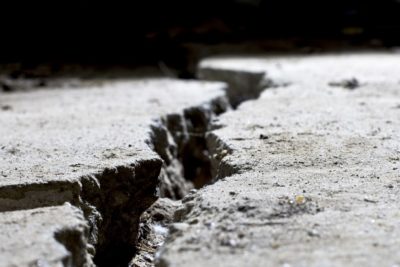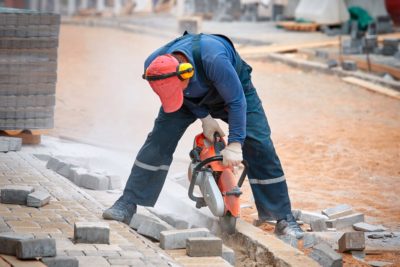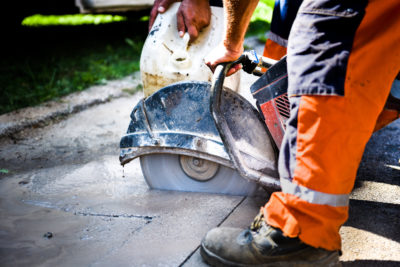Thanks to today’s technological advancements, many different concrete scanning methods exist. Various non-destructive testing methods have been developed for concrete imaging and scanning. We’ve highlighted the top four concrete scanning methods.
First Things First: Why Do We Scan Concrete?
Before looking at different concrete scanning methods, we must understand why concrete scanning is necessary.
The Dangers of Neglecting the Concrete Scanning Process
Concrete scans are vital to avoid damage to the slab and the potential repercussions.
Rebar
Since concrete is reinforced with rebar to provide added strength and safety, damage to the rebar places stress on the concrete, which is detrimental to the structure’s stability.
Post-Tensioning
Post-tension cables are another structural component that should not be compromised. Post-tensioning happens when structural cables go through concrete slabs with high pressure applied to tighten them, aiming to increase the strength of the slab.
Any damage to the post-tension cables may cause immediate injury to workers and irreparable structural damage to the post-tension slab of concrete.
Electrical Conduits, Water and Heating Lines
Concrete slabs may contain electrical conduits (plastic and metal), water lines and even radiant heating lines. Striking an electrical line could be fatal, as its dangers include worker electrocution and power outages.
Any leaks or damage to the buried water lines are hidden to the eye, which makes concrete scanning crucial. Disturbances in the electrical, water and heating lines must be repaired immediately for work to resume on a construction project.
Voids
Besides detecting the presence of reinforcement materials within the concrete, you can also use concrete scanning to detect any voids within the concrete slab.
Voids are spaces empty of reinforcement, often present in concrete due to improper technique or earlier damage. Voids could be considered areas of weakness that need further repair work, and you should assess these thoroughly.
How Do You Scan Concrete?
How do I scan a slab? Where do I start?
There are several concrete scanning methods of which to be aware.
1. Ground Penetrating Radar (GPR): What is GPR Concrete Scanning?
Ground-penetrating radar (GPR) is a widely used non-destructive concrete scanning method that pulses electromagnetic radiation through a concrete slab to determine the presence or absence of reinforcement materials.
GPR uses both a transmitter and receiver antenna and a signal processing unit to emit electromagnetic pulses with a specific central frequency. The reflected waves from the concrete’s subsurface layers and objects are captured by the receiver antenna, indicating the exact location of voids and objects.
Applications
Ground Penetrating Radar (GPR) is a cost-effective approach to scanning large areas. GPR can:
- Locate steel reinforcement in concrete elements
- Determine rebar location and spacing
- Estimate concrete cover thickness
- Locate live conduits and pipes
- Identify significant voids and irregularities in concrete slabs
- Inspect tunnel lining
Limitations
Unfortunately, GPR scans cannot provide information on the mechanical properties of concrete and its strength, nor can they measure the corrosion condition of steel reinforcement bars within concrete slabs.
2. Ultrasonic Scanning of Concrete
Ultrasonic Tomography (MIRA) scanning determines the thickness and locates delamination in a concrete slab. Ultrasonic Tomography can pick up on subsurface voids and any other defects in concrete.
Tomography uses ultrasonic shear waves to investigate the multilayer properties of concrete. This method sends stress waves through concrete through a transmitter, introducing a stress pulse into the concrete object at an accessible surface point.
The pulse is reflected at the interface of internal targets, like voids, rebar and other materials. At the receiving transducer, the emitted impulse and the reflected acoustic waves are monitored, and mathematical solvers are used to study the extent of internal irregularities.
Applications
Tomography is an effective method for evaluating concrete defects, as it:
- Estimates the thickness of concrete elements
- Detect internal voids and flaws
- Unearths shallow depth cracking and delamination
Limitations
This method of concrete scanning is ideal for smaller spaces, making it time-consuming to scan large areas. Testing on very rough concrete surfaces might also be challenging, as the sensor coupling is fragile.
3. X-Ray Scanning of Concrete
X-ray imaging in concrete is very similar to X-rays used in labs. The X-Ray process can be done either by using conventional methods or the digital medium. However, the key difference lies in how the image is processed.
Application
An X-Ray scan locates steel bars in heavily reinforced concrete elements.
Limitations
The limitations of a concrete X Ray include:
- Since this technology uses high energy X-Rays, a clearance is necessary before conducting the test. Therefore, you should keep a clear distance of about 15-25m for testing
- Most X-Ray imaging projects are performed after-hours or during night shifts to reduce the cost and efforts related to preparing for a safe clearance zone
- X-Ray scans are limited to the depth of approximately 200mm or even thinner concrete elements
- The test results can only be processed and interpreted by an experienced technician
4. Half-Cell Corrosion Potential Mapping
Half Cell corrosion mapping assesses the likelihood of corrosion activity in concrete structures. In a nutshell, a Half-Cell Test measures the potential difference between an arbitrary point on the concrete surface and a standard portable half-cell, a standard electrode. You do this test on a systematic grid, showing measurements as 2D contour maps of potential value.
Applications
This concrete scanning method:
- Evaluates the likelihood of corrosion in concrete elements, and
- Evaluates the efficacy of concrete repair
Limitations
Like all other concrete scanning methods, the Half-Cell Test has certain limitations.
- You can’t perform this test over asphalt toppings
- It’s sensitive to the humidity and temperature of concrete
- You cannot do this test on concrete elements with epoxy-coated rebar
Traditional Versus Modern Concrete Testing Methods
The Traditional Method
A concrete X-Ray is the most traditional method of scanning concrete and has become less popular due to its time-consuming nature. For an X-Ray slab scan, both sides of the concrete slab should be accessible, limiting productivity on a construction project. Not to mention that a concrete x-ray only detects certain materials within the concrete, and the necessary equipment is bulky and produces harmful radiation.
Modern Ingenuity
Modern concrete scanning technology has moved beyond the concrete X-Ray. A GPR scan offers an overview of the concrete’s subsurface. While this radar does not automatically distinguish between various materials, highly skilled GPR scanning technicians are equipped to recognise the patterns produced by these inconsistencies. With this precious information, technicians can carefully mark out the concrete, helping the contractor visualise exactly where to work.
Concrete Scanning Services
Diamond Cut Concrete specialises in all things concrete-related! We can provide concrete images to help you with your next construction project, from a traditional concrete scan to modern ground scanning methods. Contact us today for a quote.



